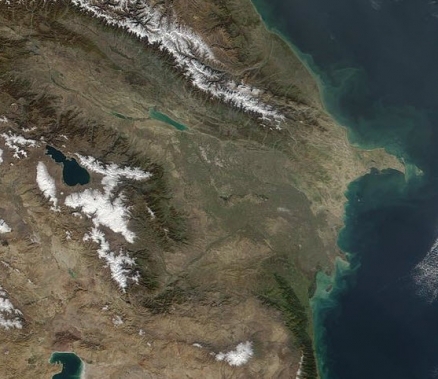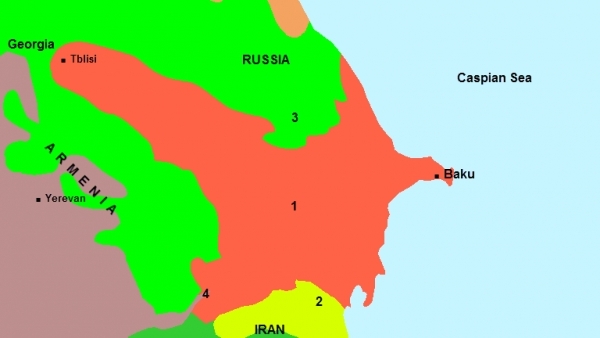Ecoregions of Azerbaijan
Ecoregions of Countries Collection 
Azerbaijan has four ecoregions as shown in the figure below:
- Azerbaijan shrub desert and steppe
- Caspian Hyrcanian mixed forests
- Caucasus mixed forests
- Eastern Anatolian montane steppe
Contents
Azerbaijan shrub desert and steppe
Seventy percent of the ecoregion is in Azerbaijan, with the rest in southeast Georgia and northwest Iran. Pistachio-juniper open woodlands and flood plain forests, as well as inner and coastal wetlands are key habitats within the region. The diversity of fauna is especially remarkable. However, conservation measures are urgently needed as fourteen species of mammals, thirty-six species of birds, and thirteen species of amphibians and reptiles are endangered, including the Persian gazelle (Gazella subgutturosa), and peregrine falcon (Falco peregrinus). Six strict nature reserves protect the biodiversity in Azerbaijan and Georgia, but unsustainable agricultural practices and poaching threaten much of the region.
In Azerbaijan, an estimated 1.2 million hectares are currently affected by steep salinity (due to excessive and long-term use of agro-chemicals), and almost 3 million hectares are damaged by overgrazing and uncontrolled logging. Flood plain forests and pistachio-juniper woodlands remain on only 5-7% of their original range. Stripped hyena has become a critically endangered species in the region. The only viable population of gazelle (up to 3,500 individuals) is in Shirvan Nature Reserve.
Caspian Hyrcanian mixed forests
This ecoregion covers the Lenkoran lowland and Talysh mountains of southeast Azerbaijan and adjoining territories of northwest Iran along the Caspian shoreline. The mixed forests of the southern coast of the Caspian Sea represent a key habitat for many different species of avifauna. Migratory species visit the area on stopovers between Russia and Africa. Other species, such as little bustard (Otis tetrax), peregrine falcon (Falco peregrinus), and squacco heron (Ardeola ralloides) use it as breeding grounds. Hyrcanian forests are relicts from the Tertiary. Consequently, they are rich in relic and endemic plant species. Several protected areas such as the Gizil-Agach strict nature reserve, the Zuvand conservation area and Girkan strict nature reserve have been set up to protect threatened flora and fauna. Habitat destruction (Land-use and land-cover change) for agriculture use is the main threat to the ecoregion.
The natural landscape has been considerably altered by intensive agriculture development. Tea, vegetables, subtropical fruit, and vine production are main agricultural activities. The most important protected protected areas areas in Azarbaijan part of this ecoregion are: the Gizil-Agach strict nature reserve (88,400 hectares (ha) wetlands and marine area, designated to protect waterfowl), the Zuvand conservation area (15,000 ha, mountain meadows and forests, designated to protect game birds, bear, leopard, and rare reptiles), and the Girkan strict nature reserve (3,000 ha, humid thermophilous Hyrcanian forests, designated to protect the unique plant communities rich in relic and endemic species).
Caucasus mixed forests
The Caucasus Mixed Forests are located at a biogeographical crossroads where flora and fauna of at least three biogeographic provinces converge. Mount Elbrus, Europe’s highest point at 5,642 meters (m) above sea level. Speciation level is high; accordingly, the Caucasus forests have one of the highest levels of endemism in the temperate world. 23 percent of vascular plants and 10 percent of vertebrates are endemic to the region. Landscape and habitat diversity favors high species richness as well – about 5,000 vascular and 7,000 lower plants (including high mountains), and 700 vertebrate animals are found in this ecoregion.
Characteristic mammals include the East and West Caucasian tur (Capra cylindricornis and Capra caucasica), chamois (Rupicapra rupicapra), Caucasian red deer (Cervus elaphus maral), wild goat (Capra aegagrus), mouflon (Ovis orientalis gmelini), brown bear (Ursus arctos), and the critically endangered Caucasus leopard (Panthera pardus ciscaucasica). Unsustainable forest use, including poor management and illegal cutting in combination with uncontrolled timber export, represent chief threats for these forest ecosystems.
Urban and rural development have converted most lowland forests to agricultural and development lands. About 5% of the region’s area have protective guidelines. Principal protected areas (Protected natural areas) are Borjomi-Kharagauli National Park, Lagodekhi and Tusheti Strict Nature Reserves in Georgia, Caucasus Biosphere Reserve in Russia, and Zakatala Reserve in Azerbaijan. The gaps in the reserve network were not assessed. Approximately 35% of mountain forests mainly remain in a natural state, but current attempts to develop commercial forestry in the region along with socio-economical crisis, which stimulates raising of the demands of local population on firewood is a potential threat to these habitats.
Urban and rural development have converted most lowland forests to agricultural and development lands. About 5% of the region’s area have protective guidelines. Principal protected areas (Protected natural areas) are Borjomi-Kharagauli National Park, Lagodekhi and Tusheti Strict Nature Reserves in Georgia, Caucasus Biosphere Reserve in Russia, and Zakatala Reserve in Azerbaijan. The gaps in the reserve network were not assessed. Approximately 35% of mountain forests mainly remain in a natural state, but current attempts to develop commercial forestry in the region along with socio-economical crisis, which stimulates raising of the demands of local population on firewood is a potential threat to these habitats.
Eastern Anatolian montane steppe
The Eastern Anatolian montane steppe [[ecoregion]’s] position at the junction of three floristic zones creates a unique biotic blend of species. Constituent landscapes of this region are floristically diverse. The mosaic of steppe and patches of woodlands, both remote and intact, are rich in terms of wildlife, too. Mammals such as the striped hyena (Hyena hyena), and marbled polecat (Vormela peregusna), birds such as the peregrine falcon (Falco peregrinus), golden eagle (Aquila chrysaetos), and reptiles such as the Armenian viper (Vipera raddei) inhabit this region. Agriculture and industrial development have contributed to most of the degradation of ecosystems. More reserves are needed to protect diverse habitats.
See also:
- Biological diversity in the Caucasus
- Biological diversity in the Irano-Anatolian
Context
Ecoregions are areas that:
[1] share a large majority of their species and ecological dynamics;
[2] share similar environmental conditions; and,
[3] interact ecologically in ways that are critical for their long-term persistence.
Scientists at the World Wildlife Fund (WWF), have established a classification system that divides the world in 867 terrestrial ecoregions, 426 freshwater ecoregions and 229 marine ecoregions that reflect the distribution of a broad range of fauna and flora across the entire planet.

